A note from APGOEF:
Today we are publishing something a bit different than our regular blog posts! It is our primary goal at APGOEF to educate and spread awareness about geoscience, so when Ken Lyon presented us with this comprehensive list of resources, we couldn’t resist sharing it with our readers. We hope you will find this compilation useful to your exploration of earth science. APGOEF does not take responsibility for the content of the resources provided, and cannot vouch for their validity.
Preface
The following is written by: Ken Lyon, MSc, P.Geo, kenlyongeo@gmail.com, Peterborough, ON
The impetus for this compilation of over 50 publications and internet resources came from Laura Mancini of the Ontario Geological Survey. Laura reached out to me in 2021 in my capacity as Newsletter Editor of the Kawartha Rock and Fossil Club. She had been contacted by someone who was looking to explore the geology of Ontario, and wondered if the Kawartha club might have something to help.
Laura’s question fit in with a list of resources that I had started compiling for rockhounds, field naturalists and other people who like these kinds of things. Perhaps now more than ever with climate change and related issues front-and-centre, we are coming to appreciate that geoscience is hugely significant and fun to learn about and explore.
In compiling this list, I have tried to offer some guidance by assigning levels to the resources ranging from Level 1 for those who know nothing or little about geology to Level 3 for those who feel comfortable with basic concepts. Resources marked with a * are particularly recommended. I have included some of my favourite books that cost money and also many good resources that are free of charge.
Level 3 and beyond takes you into the worlds of serious mineral, rock and fossil collectors and people who have taken college and university courses. This is not to say that you need formal study. I am constantly learning from members of the Kawartha and other clubs who are self-taught and know more about some topics than I ever will.
This compilation is a work-in-progress and I have made some minor revisions since 2021. Hopefully, you will find a few “nuggets” of information to help you get out and have some fun.
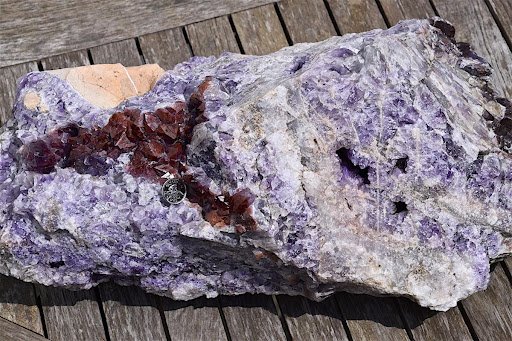
Amethyst rock from Thunder Bay area, ON.
Photo: Ken Lyon
Amethyst is a purple variety of quartz and the official gemstone of Ontario. The reddish-brown crystals on the left are amethyst crystals coated with the iron mineral, hematite. The length of the rock shown is 40 cm.
My wife bought this as a treasured addition to her rock garden.
Acknowledgements
While I take responsibility for selection of the resource list and comments, I would like to gratefully acknowledge review comments and encouragement provided by the following in alphabetical order:
- Andy Fyon, PhD, formerly of the Ontario Geological Survey;
- Kevin Kidd of the Kawartha Rock and Fossil Club and the Gem and Mineral Club of Scarborough;
- Laura Mancini, MSc, PGeo, of the Ontario Geological Survey;
- Bill Pearson, PhD, PGeo, and Deana Schwarz, PhD, PGeo, of the APGO Education Foundation; and
- Ashley Pollock of the London Gem, Mineral and Fossil Society, the Walker Mineralogical Club, and the Central Canadian Federation of Mineralogical Societies (CCFMS)
Some Important Precautions and Disclaimers
You are responsible for knowing where you can go, where you can park, what safety hazards may exist and what personal protective equipment you need, and what you can pick up and take back home.
Parking rules change from road to road and place to place.
Respect all laws and rights governing private and Crown property, and obey all rules and regulations covering any access to and from any of locations.
Bedrock outcrops and other locations can pose traffic, slip-trip-fall and other hazards. The use of hammers can be dangerous and in some cases destroys the outcrop for future observation.
Rock, mineral and fossil samples cannot be removed from protected areas such as parks and conservation areas or from private property without permission.
If you are rockhounding, please follow the CCFMS Code of Ethics for Rockhounds (https://ccfms.ca/Copied_Field_Trips.php) and Safety for Field Trippers (https://ccfms.ca/CCFMS-Safety-Rules.php).
I have not personally visited most of the sites listed and cannot vouch for the accuracy of the content of the resources.
And finally, I have to disclaim any liability in connection with the use of the information presented and my annotated comments and recommendations.
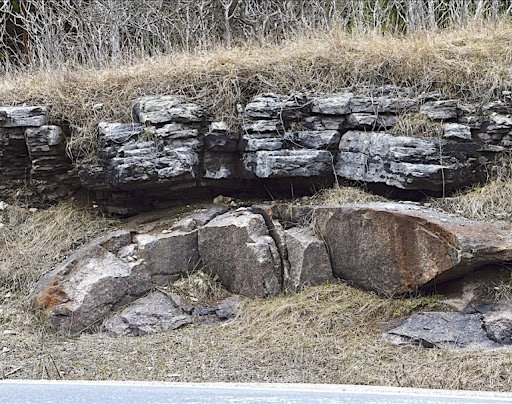
Great Unconformity bedrock outcrop at Galesburg just northeast of Peterborough in The Land Between.
Photo: Ken Lyon
Paleozoic Ordovician limestone about 450 million years old overlying Precambrian granitic mountain core about 1 billion years old; incredible time spans.
Annotated List Alphabetically by Author (or source when no author is available)
Resources marked * are particularly recommended.
Level 1 Resources
Eyles, N., 2002. Ontario Rocks: three billion years of environmental change. Fitzhenry & Whiteside, Markham, ON. 339 p.
*Level 1 – 3. Excellent book for learning about the geology of Ontario. Start with Eyles (2013) first if you are new to geology or mainly just looking for places to explore. See also Eyles and Miall (2018) in the Level 2 section.
Eyles, N., 2013. Road Rocks Ontario: over 250 geological wonders to discover. Fitzhenry & Whiteside, Markham, ON. 570 p.
*Level 1 – 2. Excellent book that introduces many geology concepts using road stops. Nick Eyles is a University of Toronto professor who rode his motorcycle around Ontario taking photos for the project.
The Central Canadian Federation of Mineralogical Societies (CCFMS)
Level 1 and up. Non-profit federation of rock, mineral and lapidary clubs for rockhounds. Member clubs are listed on the website. Clubs typically hold meetings on different topics, organize field trips and organize shows that are fun for all ages and levels.
Level 1 and up. There are several rock, mineral, fossil, lapidary groups on Facebook. Look for one in your area. There is also the Great Lakes Rocks and Minerals group with over 150,000 members, mostly USA.
Fyon, A. Canada Beneath Our Feet Website
Level 1 – 2. Covers several geology topics and Ontario locations of interest. Andy Fyon is a former Director of the Ontario Geological Survey and also maintains a Facebook page, Andy’s Northern Ontario Wildflowers, https://www.facebook.com/Andy.wildflowers.
GeoscienceINFO: Geovideos, Virtual Geology Field Trips and Blog Website
*GeoscienceINFO is funded by the APGO Education Foundation with the aim of bringing Ontario geological stories to the public’s fingertips. Content includes 17 virtual field trips, geotrails along the southern portion of the Niagara Escarpment and in Toronto and Hamilton, videos, and 36 blogs posted as of May 2023. New items are constantly being added. Well worth checking out.
Lemon, R.R.H., 1965. Fossils in Ontario. University of Toronto Press, Toronto, ON. 17p.
Brief overview and out-of-date, but a free download. See the Mining Matters brochure and the University of Waterloo Earth Sciences Museum website for alternatives.
Mining Matters (Undated) Guide Books
Rocks of Ontario: Ontario beneath your feet
Fossils of Ontario: Old rock – ancient life*
Introductory brochures published by the charitable organization Mining Matters. The fossil guide is good. Free downloads. Mining Matters also provides online resources and workshops for teachers and students in grades K-12.
Ontario’s Highlands Tourism Organization Website: Come wander: Discover our Hidden Gems brochure
*Level 1. Outstanding guide to the Highlands region stretching from Algonquin Park and Minden in the west to Eganville and Perth in the east. Comes with a map showing 35 road trip stops and nine provincial parks.
Ontario Ministry of Energy, Northern Development and Mines GeoTours Northern Ontario Website
*Level 1 – 2. Outstanding series of free brochures on walking tours at 10 locations from Thunder Bay to Parry Sound plus seven locations in the Sudbury area. Compiled by geoscientists from the Geological Survey of Canada, Ontario Geological Survey, Dynamic Earth Science Centre and Laurentian University.
*Levels 1 to 3. The ROM Department of Natural History collections comprise one of the largest holdings of natural history specimens in Canada. It is involved in studying living species, researching and displaying fossilized plants and animals from all over the world, and in acquiring and studying the best examples of minerals, gems, meteorites and rocks from our planet and solar system.
Sudol, S., 2010. Brief History of Ontario Mining
I am not a mining or exploration specialist, but this article seems like a good overview of our rich heritage in mining resources. Ontario has been a global player in this sector.
University of Toronto Scarborough Campus, Let’s Rock Ontario Website
*Outstanding internet guide to more than 500 Ontario geology sites
University of Waterloo Earth Sciences Museum
*I haven’t been to the museum yet, but it maintains a good website that includes online resources for geology, minerals, fossils, ice age mammals, and mining in Ontario. The museum also maintains the Peter Russell Rock Garden, billed as the largest geologic garden in Canada.
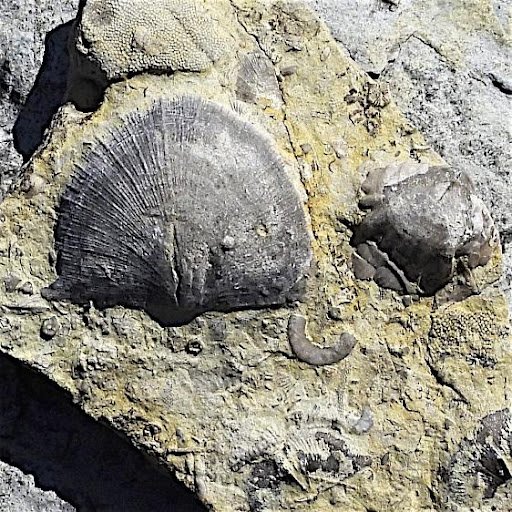
Brachiopod and bryozoa fossils in limestone near Lindsay, ON.
Photo: Don McLeod used with permission. Don maintains a good nature blog at https://www.donaldmcleod.com
Fossiliferous Ordovician limestone about 450 million years old. At the time we were under a warm shallow sea south of the equator. The large fossil is about 3 cm across.
Other Museums, Science Centres, Geo-Parks
There are many museums and other facilities across southern Ontario that feature geology exhibits. Here are a few that were recommended by my reviewers:
Additional Fossil Resources
Some additional fossil references recommended by my reviewers are listed below:
- Brunton, F., E. Turner, and D. Armstrong, 2009. A Guide to the Paleozoic Geology and Fossils of Manitoulin Island and northern Bruce Peninsula, Ontario, Canada. Canadian Paleontology Conference Field Trip Guide No. 14.
- Hessin, W.A., 2009. South-Central Ontario Fossils: a guide to the ancient marine life of the region. Self-published, Cobourg, ON. 288p.
- Verma, H.M., 1979. Geology and Fossils: Craigleith Area Ontario. Ontario Geological Survey Guidebook No. 7
Level 2 Resources
Chapman, L.J., and D.F. Putnam, 1984. The Physiography of Southern Ontario (3rd Ed.). Ontario Geological Survey, Special Volume 2. 270p. Accompanied by Map P.2715, Scale 1:600,000.
Five regional maps, 2224-2227, at smaller scales also available as downloads.
Eyles, N., and A. Miall, 2018. Canada Rocks: the great geologic journey – second edition. Fitzhenry & Whiteside, Markham, ON. 550 p.
*Level 2 and up. Both Eyles and Miall (2018) and Fensome et al. (2014) are both good introductions to Canadian and Ontario geology. Eyles and Miall (2018) is more detailed and at a somewhat higher level.
Fensome, R, et al. (Editors), 2014. Four Billion Years and Counting: Canada’s geological heritage. Canadian Federation of Earth Sciences, 402p.
*Level 2 and up. See Eyles and Miall (2018).
*Level 2 and up. Mindat is the world’s largest open database of minerals, rocks and meteorites and the localities they come from. The database includes comprehensive details for about 8,700 mineral and rock specimens, 375,000 worldwide localities including Ontario, and over 1 million photos. An outstanding “go-to” website for geologists, collectors and the public.
Level 2 and up. Includes some nice photos of igneous and metamorphic rock slabs from the Canadian Shield.
Sabina, A.P., 2016. Information for Collectors. Geological Survey of Canada Open File 7869.
*Level 2 and up. An outstanding compilation of resources for exploring geology in general and Canadian geology in particular and for collecting minerals, rocks, fossils and gems.
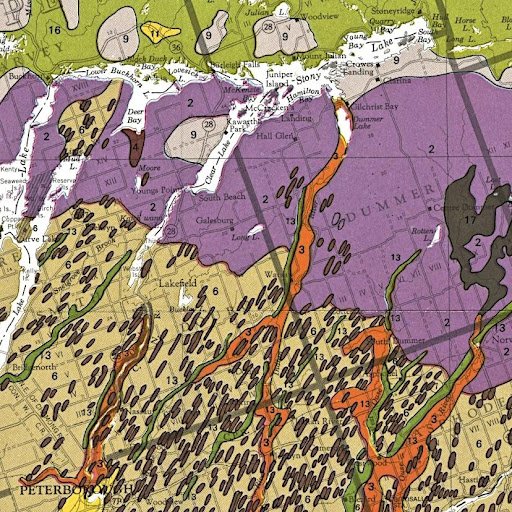
Physiographic features of the Peterborough – Stoney Lake, ON area.
Small portion of Physiography of the South Central Portion of Southern Ontario. Ont. Dept. of Mines and Northern Affairs, Map 2226. Scale 1:253,440. © Queen’s Printer for Ontario 1972. Reprinted 1984 with minor revisions.
Features shown include till moraine (purple), sand plains (light tan), glacial spillways (orange), eskers (green) and drumlins (dark brown).
Level 3 Resources
Level 3 and up. Most current compilation of information that I know of on the subject.
Ministry of Mines GeologyOntario Hub
*Level 2 and up. Provides search tools for geoscience data and information including Ontario Geological Survey (OGS) publications, Ontario Mineral Inventory, abandoned mines, geological exploration results on Crown land, and geoscience data viewable in Google Earth (OGSEarth). Available layers include bedrock geology and topography, mining claims, Quaternary geology and physiography.
Similar to Ministry of Mines GeologyOntario Hub, this Ontario government webpage, Geology and Geoscience, provides links to OGS programs and online resources, Geo Labs, Northern Ontario Geo Tours as well as GeologyOntario and OGSEarth.
Ontario Geological Survey, Bedrock Geology Maps (1991)
Map 2544, Bedrock Geology of Ontario, Southern Sheet. Scale 1:1,000,000.
Map 2541, Bedrock Geology of Ontario, Northern Sheet. Scale 1:1,000,000.
Maps show bedrock geology of the province. Some road locations and geology descriptions have changed and many new roads have been built. Free downloads.
Land Information Ontario, Ontario GeoHub Website
Level 3 and up. Provides links to geospatial databases. The most useful mapping application at an introductory level is Make a Topographic Map.
Robinson, G.W., J. Chiaranzelli, and M. Bainbridge, 2019. Minerals of the Grenville Province: New York, Ontario, and Quebec. Schiffer Publishing, Atglen, PA. 207 p.
*Level 3 and up. Beautifully illustrated book with more than 400 photographs of over 260 minerals and mineral groups found in the Precambrian Grenville Province of the Canadian Shield.
- Misc. Report 32, 1983. Kingston, Ontario to Lac St-John, Quebec
- Misc. Report 33, 1986. Buckingham – Mont-Laurier – Grenville, Quebec; Hawkesbury – Ottawa, Ontario
- Misc. Report 39, 1986. Bancroft – Parry Sound Area and Southern Ontario
- Misc. Report 41, 1987. Hull – Maniwaki, Quebec; Ottawa – Peterborough, Ontario
- Misc. Report 48, 2007. Ottawa to North Bay and Huntsville, Ontario; Gatineau (Hull) to Waltham and Temiskaming, Quebec
- Misc. Report 49, 1991. Sudbury to Winnipeg. https://doi.org/10.4095/132238
- Misc. Report 57, 2000. Cobalt – Belleterre – Timmins, Ontario and Quebec
- Misc. Report 77, 2003. Kirkland Lake – Rouyn-Noranda – Val-d’Or, Ontario and Quebec
Level 3 and up. Ann Sabina of the Geological Survey of Canada wrote an outstanding series of collector guide books from the 1970s through to the 2010s. GEOSCAN links can be frustrating because you usually have to click on two or three links to be able to download a pdf or zip file.
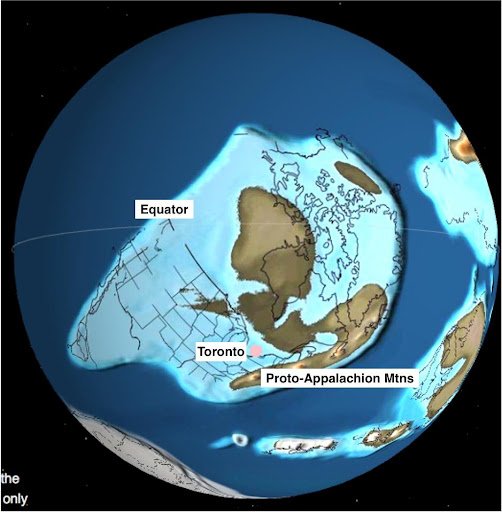
Ordovician shallow seas and Laurentia continent about 450 million years ago.
Graphic: Ian Webster, DinosaurPictures.org used with permission.
Brown represents land, light blue is shallow continental seas, and dark blue is deep ocean.
The brown and light blue blob in the centre is the continent Laurentia, the dark blue to the right is Iapetus Ocean. The pink dot south of the equator and under a shallow sea is where Toronto would have been located.
General Geoscience Educational Resources
There are thousands of general geology publications and internet resources, and this is not a guide to them. However, of the ones that I have looked at, a few of my favourites are listed below. See also Ann Sabina’s (2016) book, Information for Collectors.
Bonewitz, R.L., 2008. Rock and Gem: the definitive guide to rocks, minerals, gems, and fossils. Smithsonian Project Consultants, M. Carruthers and R. Efthim. Dorling Kindersley Limited, New York, NY. 360 p.
Level 1 – 3. This is one of if not the best of several introductory guides to rocks and minerals. Has good illustrations and photos and tie-ins to why rocks and minerals have been and continue to be important to us. I go to other sources for fossils.
British Geological Survey, Discovering Geology Website
Level 1 and up. Good website. The origins of modern geology can be traced back to the Industrial Revolution and the work of British and European geologists from the late 1700s to the 1830s. British geologists have been world leaders ever since. Canadians are world leaders too because of our incredible geology heritage.
Geology.com: Geoscience and Earth Science News and Information
Level 1 and up. One of the best internet sites about geology with lots of topics and current news. Family-owned business that is self-funded through advertising revenue.
Knoll, A.H., 2021. A Brief History of Earth: Four billion years in eight chapters. Custom House/ HarperCollins, Toronto, ON, 272 p.
Level 1 – 3. Great book that ties together physical geology, the geologic time scale, climate change, evolution of life, and mass extinctions.
Level 1 – 3. The best open-license introduction to earth science at the college and university level that I have found so far, although I do not always agree with the content.
Webster, I., and C.R. Scotese, 2016. What Did Earth Look Like Years Ago?
Level 1 – 2. Fascinating illustrations of continent locations from 750 to 20 million years ago. Pick a location like Toronto and see where it’s moved over time. You can also search for 1,365 dinosaurs. Based on work by the EarthByte Research group in Australia.
Whyse Jackson, P.N., 2019. Introducing Palaeontology: A guide to ancient life. Dunedin Academic Press, London, Engl. 164 p.
Level 1 – 3. Great book to learn paleontology from.
A note from APGOEF: Thanks for reaching the end of the blog! We hope you use these resources to learn about and enjoy exploring the geology of Ontario! Reach out to us (beneathyourfeetblog@geoscienceinfo.com) or Ken Lyon (kenlyongeo@gmail.com) for questions or comments.

Ken Lyon is a professional geoscientist with over 45 years’ experience in the environmental sector, mostly as a contaminated sites and hydrogeology consultant in Ontario and Alberta. He holds a BA from Princeton, an MSc from Queen’s, and was a founding member of Professional Geoscientists Ontario. He is currently course instructor at Trent University where he teaches Trent’s second-year course on environmental geology and president of the Kawartha Rock and Fossil Club.

